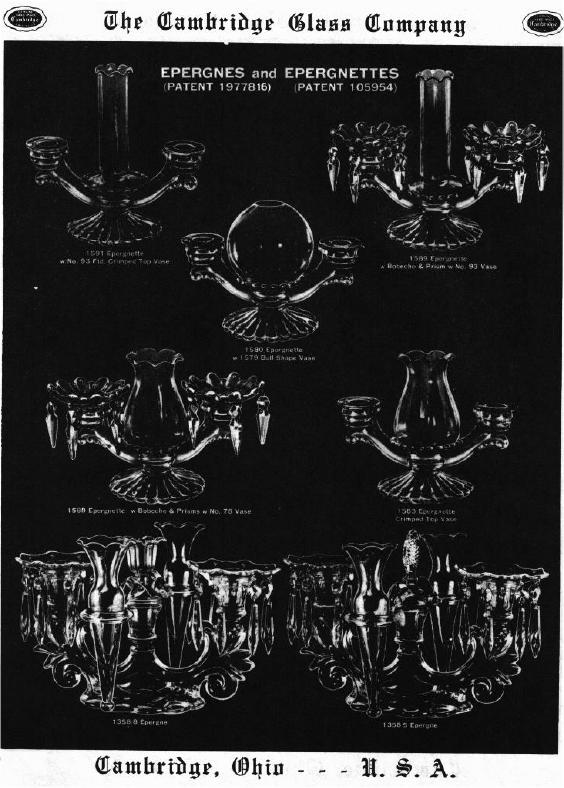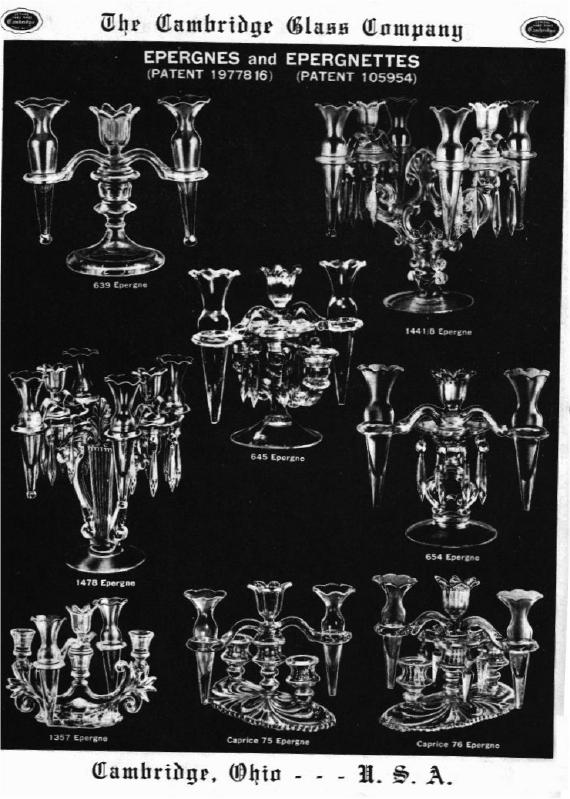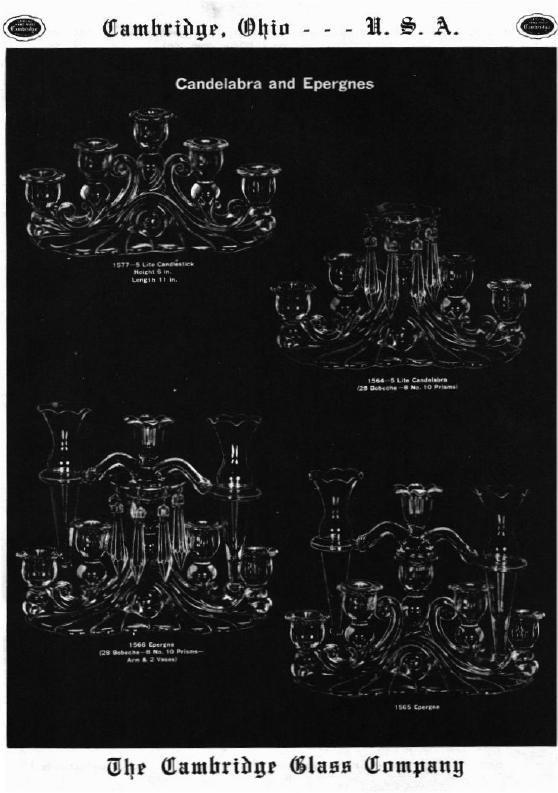Epergnes & Epergnettes Part II
by Mark A.
Nye
Issue No. 223 - November 1991
The Cambridge Glass Co. used the term epergne to describe a combination consisting of any candlestick to which a detachable arm that held vases had been added. The arm consisted of a vase holding ring at either end and in the center either a candle pocket or a decorative knob, depending upon the arm model, and was produced in three sizes. The vases used with these arms lacked a foot and thus, could not stand by themselves. The vases were made in two styles, with and without a small knob at the bottom. The patent application for the combined flower vase holder and candlestick was printed in the October 1991 issue, as Part I of this series dealing with epergnes and epergnettes.
The term epergnette was used by Cambridge to designate those items that served as both candle and flower holders and did not make use of a detachable arm or special vase. The 1940 Cambridge catalog offered five epergnettes and all used as their base the #1588 2-lite candlestick. Added to this base were three styles of vases, the #93 6" footed vase, the #1579 4½" ball vase, and the #78 4½" crimped top vase; the latter similar in shape to a hurricane shade.
Jess Clair Kelly of the Cambridge Glass Co. filed a design patent application for a "combined candlestick and centerpiece or similar article" on July 30, 1937 and it was granted a month later. The item for which the design patent was obtained is the #1558 two-light candlestick and shown with this article is the patent announcement as it appeared in the September 7, 1937 issue of the U.S. Patent Office Official Gazette.
With the exception of the #1579 ball shaped vase which was also produced in carmen, neither the #1588 candleholder, nor the vases added to it, were made in color. Available from the January 1940 price list was the #1580 Epergnette with either a crystal or carmen vase, the latter priced at $3 more a dozen than those with a crystal vase. The #1591, #1583 and #1580 with crystal vase listed at $30 per dozen (approximately 52 years ago) while the #1589 and #1588 with their #23 bobeches and 10 #5 prisms were quite expensive at $82.50 per dozen.
Epergnettes probably came on the market as soon as the patent application was filed and were discontinued during the 1940s as none appear in the 1949 or later catalogs and price lists.
Exactly when the first Cambridge epergnes were placed on the market has not been learned, however, trade advertising promoting epergnes and dating to 1935 has been found. More than likely, the first epergnes were shown to the trade either as soon as the patent application was filed or after it was granted in the fall of 1934. Epergnes, although fewer in number than in the 1940s, were shown in the final Cambridge catalog.
There were two styles of vase arms used for epergnes; one having a candle holder in the center and one with a knob in the center. There were three arms with a center candle holder, these being the #1436, #1437 and #1438, used to assemble the epergnes shown in the 1940 catalog and a single one with a center knob, the #1435. At one time there were two additional arms with the center knob, one of which had a different style knob. The only distinguishing difference between the three with the candle holder in the center is their size and the dimensions of each are provided below;
| Arm | Arm Width | Inside Ring Diameter | |
|---|---|---|---|
| #1436 | 7¾" | 1" | |
| #1437 | 9" | 1 1/8" | |
| #1438 | 10½" | 1½" |
The overall width may vary slightly, perhaps as much as 1/4", but this does not indicate a different size. This minor variation in width is the result of the arm sagging after it was removed from the mold.
The #1435 arm with center knob is the same size as the #1438, that is approximately 10½" wide. The other two arms with center knobs will correspond in size to the #1436 and #1437.
The #1358/8 epergne utilizes the #1438 arm, #19 bobeches and #1 1 1/2" prism. It remained in the Cambridge line until the final closing; however, in later years was known simply as the #1358. The arm used for the #1358/5 is the #1435; this item had been discontinued by 1949.
The #639 made use of the #1436 arm and the #639 single-lite candlestick. The epergne was not offered after the mid-1940s and of the three arms with center candle holders, the #1436 is the most difficult to find.
The two Caprice epergnes, #75 and #76, shown in the accompanying illustrations (see page 8), are comprised of the Caprice #74 3-lite candleholder, the #1437 arm, and in the case of the #76 epergne, a #21 bobeche (square in shape) and #5 prisms. Neither of these epergnes remained in the Cambridge line when the June 1949 catalog was issued.
Epergne #1357 is identical to the #1358/8 (aka #1358) except for the absence of bobeches and prisms. It did remain a part of the Cambridge line throughout the final years.
Both #645 and #663 (not illustrated) epergnes use as their base the #1037 3-lite candleholder and added to it, in both cases, is the #1438 arm. The #645 differs from the #663 in that it also has a #19 bobeche and 8 prisms, something that the #663 does not have. These two items also made it into the final Cambridge catalog.
The #654 comes from the familiar #646 single lite candlestick and uses the #1438 arm, #19 bobeche and #1 prisms. While the candlestick itself is shown in the 1949 catalog, as is a candelabrum based on it, the epergne was no longer listed.
The #1441/8 and #1478 each use two #1438 arms, 4 vases, 2 #19 bobeches and 16 #1 prisms on their respective base candleholders. Neither of these were available in 1949 or later years.
The five-lite Caprice candleholder was also used as the basis for several epergnes, two of which are the #1566 and #1565. Both of these use the #1438 arm in the middle or highest candleholder and differ only by the bobeche and 8 #10 prisms present in the case of #1566.
At this time, no item numbers have been found for the various vases used for the Cambridge epergnes. Obviously, there are three sizes to fit the three ring diameters, as well as those with and without the terminal knob. Hopefully additional research will provide item numbers for the vases.



